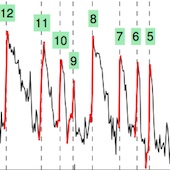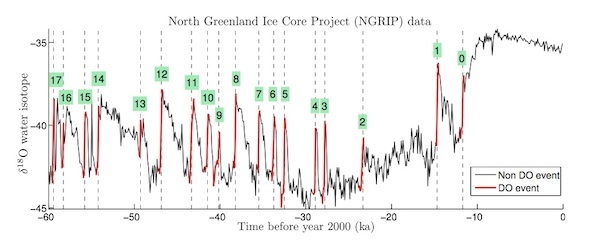Climate Tipping Points

This project aimed at gaining knowledge about the typical statistical behaviour of paleoclimate data series before the occurrence of a tipping point to allow the detection of warning signs for upcoming abrupt climate transitions. Tools developped in the field of machine learning and soft computing were applied to Greenland ice core data to provide insights on the dynamical system under study.
The project
In this project we proposed a time series segmentation algorithm combining a clustering technique and a genetic algorithm to automatically find segments sharing common patterns from paleoclimate time series. The segments were transformed into a six-dimensional space composed of six statistical measures most of which have been previously considered in the detection of critical transitions.
Experimental results showed that the proposed approach applied to paleoclimate data could effectively assess warning signals of Dansgaard-Oeschger (DO) events and uncover commonalities and differences in their statistical and dynamical behaviour. In particular, strong warning signals were detected in the GISP2 and NGRIP δ18O ice core data for several DO events (e.g. DO 1, 4, 8 & 12) in the form of increasing variance, autocorrelation and mean square error. The increase in mean square error, suggesting nonlinear behaviour, has been found to correspond with an increase in variance prior to several DO events for ∼90% of the algorithm runs for the GISP2 δ18O dataset and for ∼100% of the algorithm runs for the NGRIP δ18O dataset. The proposed approach applied to paleoclimate data provides a novel visualisation tool in the field of climate time series analysis of critical transitions.

For more information
This project was conducted in the framework of the Ariadna Project: Climate tipping points: Detection and analysis of patterns using an ordinal regression approach - Study Reference Number: 13-9202. For more information please find the study description.
This work was presented at the conference on Hybrid Artificial Intelligence Systems (HAIS); the manuscript can be found here:
Perez-Ortiz, M., Gutierrez, P. A., Sanchez-Monedero, J., Hervas-Martinez, C., Nikolaou, A., Dicaire, I., and Fenandez-Navarro, F.,Time Series Segmentation of Paleoclimate Tipping Points by an Evolutionary Algorithm, Proceedings 9th Conference on Hybrid Artificial Intelligence Systems, Salamanca, Spain 2014. (link)
Results were published in the International Journal Climate Dynamics, accessible via the link below:
Nikolaou, A., Gutierrez, P.A., Duran, A., Dicaire, I., Fernandez-Navarro, F., and Hervas-Martinez, C., Detection of Early Warning Signals in Paleoclimate Data using a Genetic Time Series Segmentation Algorithm, Climate Dynamics, Springer Berlin Heidelberg, pp.1-15, 2014. (link)